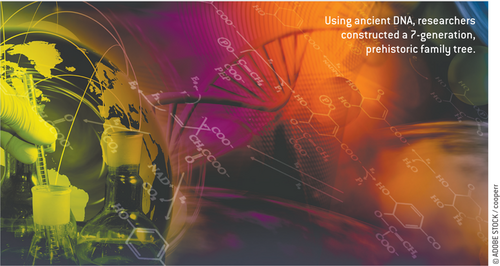Neolithic Community Revealed Using Ancient DNA Data
Investigation of a Neolithic burial site sheds light on the social organization of a 6,700-year-old community
The Neolithic period is estimated to have emerged approximately 12,000 years ago in the Near East. Also called the New Stone Age, the period is associated with the beginning of a settled lifestyle based on farming rather than hunting and gathering. The human ability to produce and store food ultimately led to the development of new social customs built on wealth, along with the eventual formation of social hierarchies. The first communities of farmers arrived around 5200-5000 BCE, during the early phases of the Neolithic diffusion, in what is now the northern region of modern-day France (Rivollat et al., 2023). Following the initial expansion period, groups tended to segment into several cultural entities, which stabilized during the Middle Neolithic, and led to smaller territories that sometimes competed. As time passed, these settled societies became increasingly complex.
The Study
“This is the first time that we are able to reconstruct such a massive pedigree for such an ancient period; we are talking about 7,000 years ago,” says study author Maïté Rivollat, PhD, from the Department of Archaeology at Ghent University in Belgium. “We can now explore new aspects of the prehistoric groups, such as social structure, in terms of within and inter-group mobility, residence patterns—combined with strontium isotopic data—and connections with other groups from a biological and spatial perspective.” The new research, Dr. Rivollat notes, also enhances use of the site for information on chronological organization and time of use. “All these aspects were impossible to discuss before,” she says. “We are opening new windows on the past.”
For their study, Dr. Rivollat and colleagues investigated the intrasite structure and characteristics of the burial site at Gurgy by sampling the remains of 110 out of the 128 individuals who had suitable skeletal preservation. They were also able to retrieve genome-wide ancient DNA data for 94 individuals, and immune gene data was generated for 82 of them. The team also gathered mitogenome data for 99 persons and Y-chromosome data for 57 persons in this cohort. The investigators then combined strontium isotope ratio values, mitochondrial DNA (maternal lineages), Y-chromosome (paternal lineages) data, age at death, and genetic sex, and were able to reconstruct 2 family trees. The first tree connected 64 individuals over 7 generations, which is the largest pedigree ever reconstructed from ancient DNA to date. The second tree connected 12 individuals over 5 generations.
The researchers’ findings showed that the generations were linked almost exclusively through the male line, with all descendants except one connected to the family tree through their fathers’ lineage. The Y-chromosome haplogroup G2a2b2a1a2 (terminal SNP Z38302) was carried by nearly all (51 out of 57) male individuals and is identified as the main male lineage of the group. Another finding revealed that most of the women were not of local origin, suggesting the practice of patrilocality, in which sons stayed where they were born and had children with females from outside of Gurgy. Conversely, most of the lineage's adult daughters are missing, which is in line with female exogamy and potentially indicates a reciprocal exchange system.
The researchers also observed that families tended to be large and had a high fertility rate. There was also a lack of half-siblings, suggesting neither polygamous nor serial monogamous reproductive partnerships.
“One must presume that the individuals buried [at Gurgy Les Noisats] could represent a fragment of the society at the time.”
— Eve Fernandez-Dominguez, PhD
Weighing In
Eva Fernandez-Dominguez, PhD, Associate Professor in ancient DNA, Department of Archaeology, Durham University, UK, cites “the fine-grained resolution achieved in the reconstruction of the pedigrees, and the fact that family relationships at the site span for 5 or 7 generations” as the main significance of the study. “In contrast with other studies addressing biological kinship in prehistoric necropolises,” she says, “Gurgy Les Noisats was a non-monumental site. So, one must presume that the individuals buried there could indeed represent a fragment of the society at the time, and not an elite or restricted group.”
Dr. Fernandez-Dominguez points out that the development of high-throughput sequencing protocols and their application to the study of ancient, heavily degraded DNA has marked an inflexion point in the field, enabling access to genome-wide genetic information. “The applications are multiple: disentangling species genetic introgression, identifying and dating population admixture events, and more recently, reconstructing close biological kinship in burial contexts.
“However, it is important to acknowledge that social organization is multi-dimensional, not necessarily always based on kin, and that multiple models of social organization can co-exist in the same group or territory,” Dr. Fernandez-Dominguez continues. “These aspects are beyond the scope of archaeogenetic analysis. The beauty of this study is that it successfully integrates elements of archaeological science such as ancient DNA, osteoarchaeology, high-resolution individual chronologies, and isotopes of mobility with a more traditional, contextual archaeological analysis. This allows the team to provide a compelling interpretation of the social organization of the individuals that once inhabited the region during the Middle Neolithic.”





